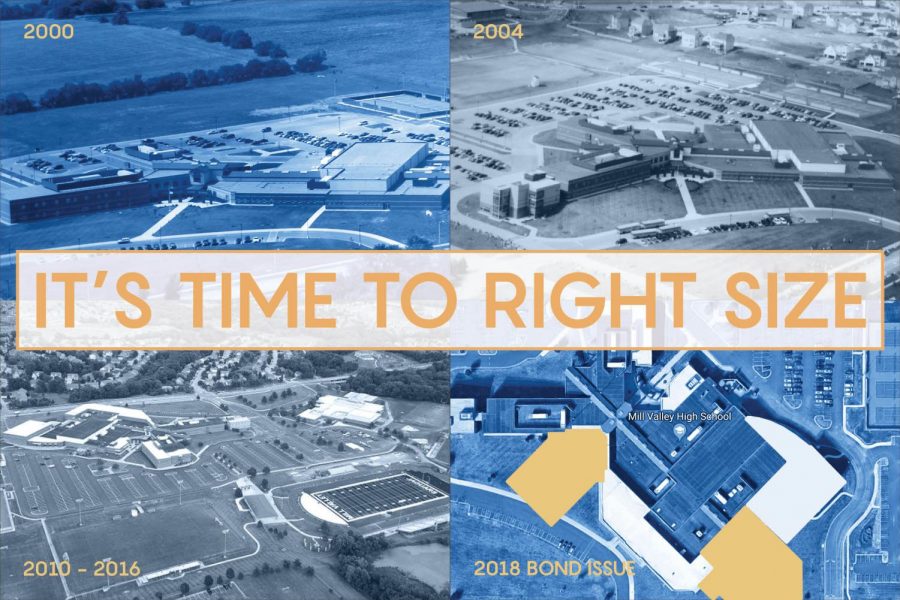In 2000, Mill Valley opened in a school designed for 750 students. With continued growth in Shawnee, more space was needed, so a bond passed in 2004 which added to the A-wing, increasing capacity to 1,000 students. Another bond passed in 2010 which brought the addition of the C-wing, auxiliary gym and added on to B-wing, raising capacity to 1,500 students. The board has now proposed a fourth bond with six different areas of needs, including additions to make MV’s current facilities the right size for students.
Proposed bond may fund increased space and facilities
The bond is now up for the vote, with ballots due noon on Tuesday, May 1
April 12, 2018
USD 232 residents now have the ability to vote on an $85 million bond issue that will address six needs for schools in the district: safety and security, educational technology, career and technology education, early childhood, school facilities and future needs.
The bond issue was proposed to alleviate these needs, without increasing the tax rate.
Taxpayers are currently paying for the previous bond, which sponsored the expansion of DHS as well as the construction of Starside Elementary and other facilities, so taxes will remain the same if the new bond is adopted. Ballots are due by noon on Tuesday, May 1.
Facilities
Spaces designed for 750 students now require larger facilities
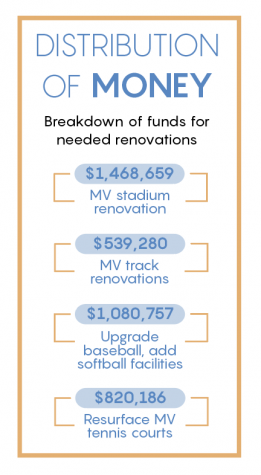 A large portion of the funds will be allocated to larger facilities, such as a bigger theater, competition gym, weight room and a new fieldhouse.
A large portion of the funds will be allocated to larger facilities, such as a bigger theater, competition gym, weight room and a new fieldhouse.
The theater addition is highly anticipated by drama teacher Jon Copeland, who believes that increasing capacity from 354 to 800 people will provide new opportunities for students.
“There’s just a number of technical things that are lacking in our theatre,” Copeland said. “We’re not really equipped to deal with the large scale shows we do here on a regular basis.”
Similarly, sophomore Park Zebley believes a larger theater would be more effective for shows.
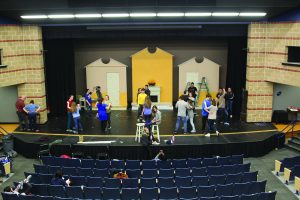
Members of “Pride and Prejudice” cast attempt to learn a ballroom dance for the upcoming play on Monday, April 2, while set pieces remain on stage due to limited space availability.
“Our current theater right now is great, but it’s a bit lacking on wing space, seating space, space in general,” Zebley said. “A bigger theater would let the theater department put on more efficient and elaborate shows.”
Band director Deb Steiner would also be able to take advantage of a larger theatre.
“We’d actually get to the play in the theatre as opposed to the gym,” Steiner said. “We’ve never been able to have a concert band on a stage; this would mean that we could actually do that.”
Other plans in the bond call for a larger competition gym and stadium fieldhouse that would accommodate larger crowds at 6A-level competitions.
The fieldhouse is used as storage for equipment such asNo shoulder pads and javelins, and houses locker rooms as well as the concession stand. The updated fieldhouse on the South end of the stadium will allow for added room, according to junior football player Steven Colling.
“It would give us space,” Colling said. “We could fit more things in there because right now we kind of have to 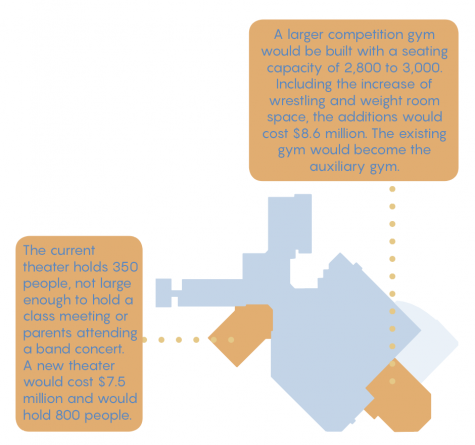 sacrifice some room for equipment, like we have showers in there that aren’t usable.”
sacrifice some room for equipment, like we have showers in there that aren’t usable.”
The plan also calls for the current auxiliary gym to be converted to a larger wrestling room. This would particularly be beneficial to the growth of the wrestling program, according to head coach Travis Keal.
“In wrestling, we’ll have more numbers,” Keal said. “Right now, I get to a certain number and I don’t cut, but I don’t go around chasing a lot more people. We don’t have enough space for them.”
Head basketball coach Michael Bennett agrees that more space is needed to support extracurricular programs.
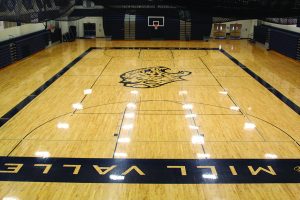
A larger competition gym would be built with a seating capacity of 2,800 to 3,000. Including the increase of wrestling and weight room space, the additions would cost $8.6 million. The existing gym would become the auxiliary gym
“As we grow and get larger, we need more space, and that space is being created with some of these building projects,” Bennett said.
Technology
Outdated AV equipment will be replaced
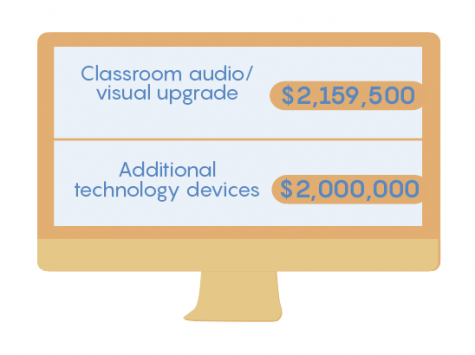 Technology updates are also be included in the bond proposal, such as replacing projectors and audio systems. Problems with the current projectors at school have been prevalent for some students, such as junior Deanna Newman.
Technology updates are also be included in the bond proposal, such as replacing projectors and audio systems. Problems with the current projectors at school have been prevalent for some students, such as junior Deanna Newman.
“During MVTV, around the weather, our projector just cuts out the livestream,” Newman said. “I’ve heard people say we should restart the stream and we’ve tried it, but it doesn’t work.”
The projector systems can also have problems with audio, according to freshman Alex Whipple.
“We’re had [situations] where we’re in a class and the teacher’s like, ‘we’re going to watch a video’ and there’s no sound,” Whipple said. “Then the teacher says, ‘I’m going to play it from my computer,’ and when you’re in the back, you can’t hear.”
In addition to replacing classroom AV equipment, the bond would also free up funds that would be reallocated to purchase new devices for students, such as laptops, benefiting students like Whipple.
“I’ve noticed when I’ll be typing a paper, the computer will just update or shut down on me, and I’ll lose what I had on the paper,” Whipple said.
Newman ultimately hopes that the replacement of AV equipment will yield better results.
“I’m looking forward to being able to watch an entire episode of MVTV without the live feed cutting out or becoming fuzzy on screen,” Newman said.
Safety and Security
Security systems, such as cameras and doors, could be updated and replaced in the bond
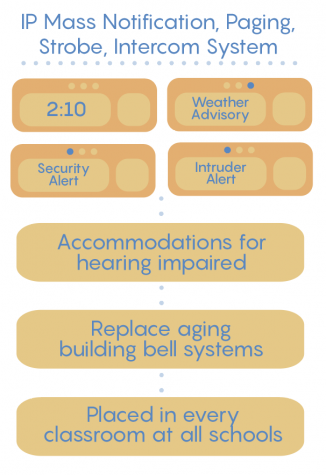 The bond proposes an update to security throughout the district, including improved entrances and communication systems. The school’s current security technology consists of “locked doors and security cameras,” according to School Resource Officer Mo Loridon.
The bond proposes an update to security throughout the district, including improved entrances and communication systems. The school’s current security technology consists of “locked doors and security cameras,” according to School Resource Officer Mo Loridon.
“I think [cameras] plays a huge role,” Loridon said. “Not only am I watching them at all times, but the secretaries are watching them and I can remote into them so I can watch the cameras from home if I need to.”
An updated security system could mean doors from the original building, such as part of A-wing, would be able to lock from the inside, reducing danger for students and teachers during a lockdown. Math teacher Laurie Deuschle is in favor of this potential upgrade.
 “I don’t keep my door locked on a regular basis because it’s annoying,” Deuschle said. “So, if we hear a suspicious noise, I can get that door locked before anybody could possibly come into our room.”
“I don’t keep my door locked on a regular basis because it’s annoying,” Deuschle said. “So, if we hear a suspicious noise, I can get that door locked before anybody could possibly come into our room.”
Thus, upgrading the current equipment is critical, according to Loridon.
“[Our security is] not weak, but with tech changes and the abilities we have now, we can just do better,” Loridon said.
Future Needs
Leftover money from bond will be used for future projects
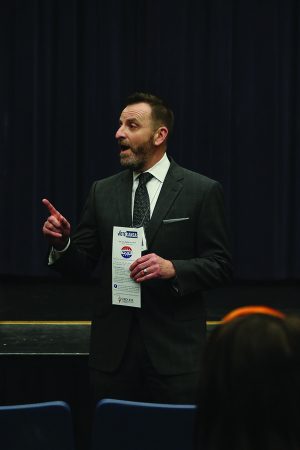
Addressing the senior class, assistant superintendent Alvie Cater explains the purpose of the bond and how students over the age of 18 by Tuesday, May 1 can vote on the bond issue.
If the bond passes, all proposed projects will begin development, but any funds left over from the aforementioned projects will be allocated to additional future needs such as land acquisition, warehouse space and storage for the grounds department.
While community member Mike Isaacsen is in favor of the bond overall, he hopes to see more focus directed to creating a new high school for the growing population.
“In the future for the district it would be great if they continue to work towards thinking about the area in the middle between Shawnee and Desoto,” Isaacsen said. “[MVHS and DHS] are both great schools, but it would be nice to have a school at some point in between the two and not worry about the overcrowding and transporting students so many miles.”
Still, Harwood said that through the 20 informational meetings the district has conducted, public response to the bond has been “very positive.”
“Recently there have been more conversations on social media,” Harwood said. “Although not everyone agrees with everything, the questions have been constructive and many of the responses have been supportive of the bond.”
Mailing of ballots began Wednesday, April 11, and all ballots are due Tuesday, May 1 by noon. The final canvass will occur Monday, May 7, and results will be announced after.
